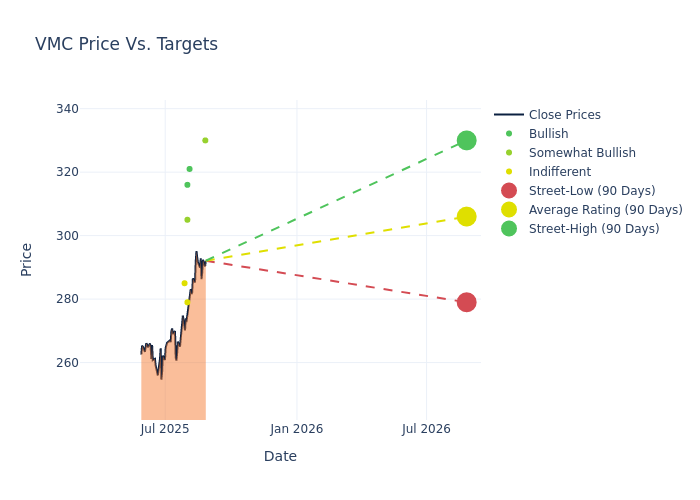Breaking Down Vulcan Materials: 6 Analysts Share Their Views
Author: Benzinga Insights | August 26, 2025 02:01pm
Throughout the last three months, 6 analysts have evaluated Vulcan Materials (NYSE:VMC), offering a diverse set of opinions from bullish to bearish.
The table below provides a snapshot of their recent ratings, showcasing how sentiments have evolved over the past 30 days and comparing them to the preceding months.
|
Bullish |
Somewhat Bullish |
Indifferent |
Somewhat Bearish |
Bearish |
| Total Ratings |
2 |
2 |
2 |
0 |
0 |
| Last 30D |
0 |
1 |
0 |
0 |
0 |
| 1M Ago |
2 |
1 |
2 |
0 |
0 |
| 2M Ago |
0 |
0 |
0 |
0 |
0 |
| 3M Ago |
0 |
0 |
0 |
0 |
0 |
In the assessment of 12-month price targets, analysts unveil insights for Vulcan Materials, presenting an average target of $306.0, a high estimate of $330.00, and a low estimate of $279.00. Observing a 3.03% increase, the current average has risen from the previous average price target of $297.00.

Breaking Down Analyst Ratings: A Detailed Examination
A comprehensive examination of how financial experts perceive Vulcan Materials is derived from recent analyst actions. The following is a detailed summary of key analysts, their recent evaluations, and adjustments to ratings and price targets.
| Analyst |
Analyst Firm |
Action Taken |
Rating |
Current Price Target |
Prior Price Target |
| Adrian Huerta |
JP Morgan |
Raises |
Overweight |
$330.00 |
$285.00 |
| Anthony Pettinari |
Citigroup |
Raises |
Buy |
$321.00 |
$305.00 |
| Steven Fisher |
UBS |
Lowers |
Buy |
$316.00 |
$318.00 |
| Anthony Codling |
RBC Capital |
Lowers |
Sector Perform |
$279.00 |
$286.00 |
| Adam Seiden |
Barclays |
Raises |
Overweight |
$305.00 |
$285.00 |
| Angel Castillo |
Morgan Stanley |
Lowers |
Equal-Weight |
$285.00 |
$303.00 |
Key Insights:
- Action Taken: Analysts adapt their recommendations to changing market conditions and company performance. Whether they 'Maintain', 'Raise' or 'Lower' their stance, it reflects their response to recent developments related to Vulcan Materials. This information provides a snapshot of how analysts perceive the current state of the company.
- Rating: Offering insights into predictions, analysts assign qualitative values, from 'Outperform' to 'Underperform'. These ratings convey expectations for the relative performance of Vulcan Materials compared to the broader market.
- Price Targets: Analysts predict movements in price targets, offering estimates for Vulcan Materials's future value. Examining the current and prior targets offers insights into analysts' evolving expectations.
For valuable insights into Vulcan Materials's market performance, consider these analyst evaluations alongside crucial financial indicators. Stay well-informed and make prudent decisions using our Ratings Table.
Stay up to date on Vulcan Materials analyst ratings.
Delving into Vulcan Materials's Background
Vulcan Materials is the United States' largest producer of construction aggregates (crushed stone, sand, and gravel). Its largest markets include Texas, California, Virginia, Tennessee, Georgia, Florida, North Carolina, and Alabama. In 2024, Vulcan sold 219.9 million tons of aggregates, 13.6 million tons of asphalt mix, and 3.6 million cubic yards of ready-mix. As of Dec. 31, 2024, the company had 16.5 billion tons of aggregates reserves.
Financial Milestones: Vulcan Materials's Journey
Market Capitalization Analysis: With a profound presence, the company's market capitalization is above industry averages. This reflects substantial size and strong market recognition.
Revenue Growth: Vulcan Materials's remarkable performance in 3M is evident. As of 30 June, 2025, the company achieved an impressive revenue growth rate of 4.37%. This signifies a substantial increase in the company's top-line earnings. In comparison to its industry peers, the company trails behind with a growth rate lower than the average among peers in the Materials sector.
Net Margin: The company's net margin is a standout performer, exceeding industry averages. With an impressive net margin of 15.26%, the company showcases strong profitability and effective cost control.
Return on Equity (ROE): Vulcan Materials's ROE lags behind industry averages, suggesting challenges in maximizing returns on equity capital. With an ROE of 3.88%, the company may face hurdles in achieving optimal financial performance.
Return on Assets (ROA): Vulcan Materials's ROA is below industry standards, pointing towards difficulties in efficiently utilizing assets. With an ROA of 1.91%, the company may encounter challenges in delivering satisfactory returns from its assets.
Debt Management: Vulcan Materials's debt-to-equity ratio is notably higher than the industry average. With a ratio of 0.65, the company relies more heavily on borrowed funds, indicating a higher level of financial risk.
Understanding the Relevance of Analyst Ratings
Ratings come from analysts, or specialists within banking and financial systems that report for specific stocks or defined sectors (typically once per quarter for each stock). Analysts usually derive their information from company conference calls and meetings, financial statements, and conversations with important insiders to reach their decisions.
Some analysts also offer predictions for helpful metrics such as earnings, revenue, and growth estimates to provide further guidance as to what to do with certain tickers. It is important to keep in mind that while stock and sector analysts are specialists, they are also human and can only forecast their beliefs to traders.
Which Stocks Are Analysts Recommending Now?
Benzinga Edge gives you instant access to all major analyst upgrades, downgrades, and price targets. Sort by accuracy, upside potential, and more. Click here to stay ahead of the market.
This article was generated by Benzinga's automated content engine and reviewed by an editor.
Posted In: VMC





